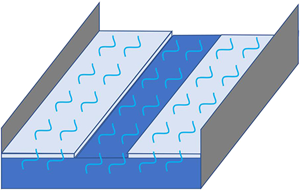Article contents
Flexural-gravity waves in ice channel with a lead
Published online by Cambridge University Press: 28 June 2021
Abstract

The flexural-gravity symmetric waves propagating in an ice channel with a lead of open water in the ice cover are investigated within the linear theory of hydroelasticity. The ice sheets are modelled as either elastic or as rigid plates. Deflections of the elastic ice sheets are described by the linear elastic plate equation. The flexural-gravity waves propagating along the channel and their dispersion relations are obtained by the normal mode method. It is shown that the dispersion relations for elastic ice approach the dispersion relations for rigid ice as the rigidity of ice increases or the wavelength decreases. The region in the plane ice thickness/wavenumber, where the ice cover can be treated as rigid with a prescribed accuracy, is determined. The effects of the ice thickness and width of the lead on the phase speeds are studied to determine critical speeds of a vehicle moving along the channel. It is shown that wave modes have several critical speeds, which may merge for some parameters of the channel. The presence of the lead significantly changes the characteristics of waves in an ice channel. Short waves, which propagate in a channel fully covered with ice, weakly depend on gravity and the presence of water in the channel. However, short waves propagating in the same channel but with a lead of open water are gravity-dominated waves localised in the lead. We conclude that flexural-gravity waves in an ice channel with a lead are less pronounced than in the channel completely covered by ice.
- Type
- JFM Papers
- Information
- Copyright
- © The Author(s), 2021. Published by Cambridge University Press
References
REFERENCES
- 9
- Cited by



